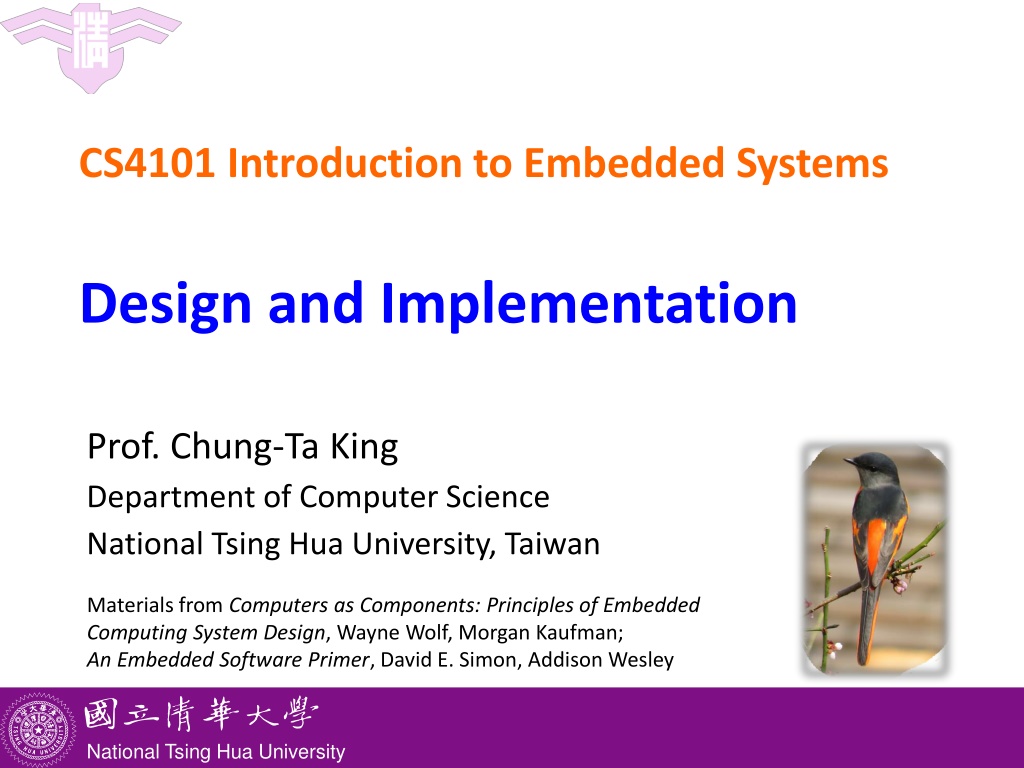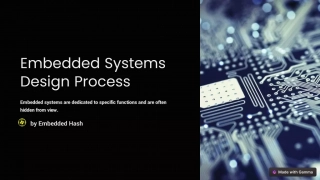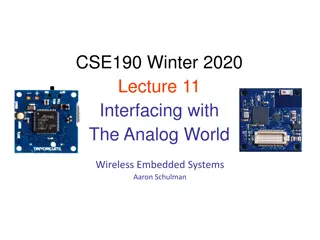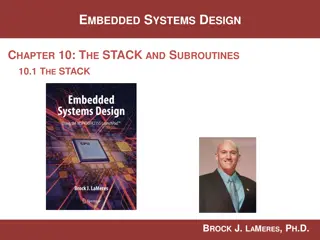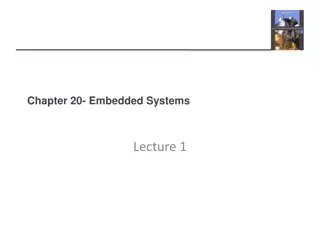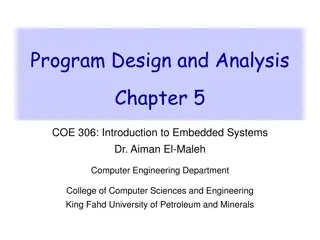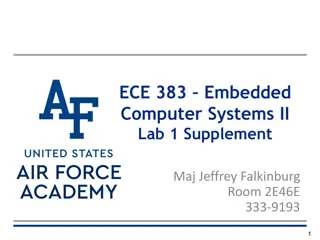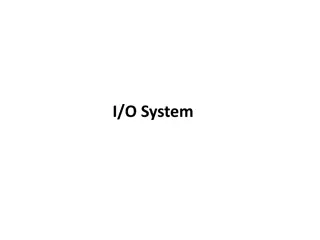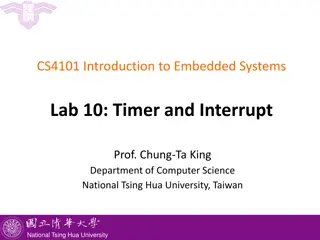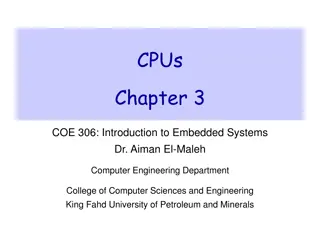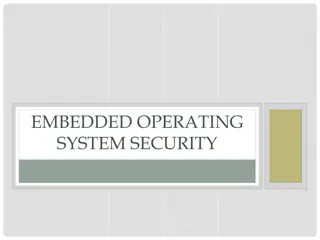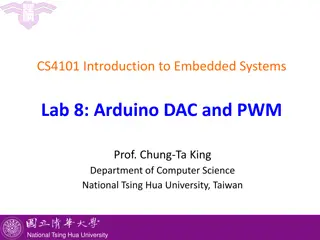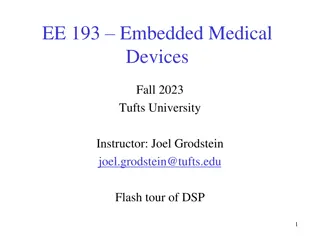Embedded Systems Design: An Introduction to Developing Smart Devices
Delve into the world of embedded systems design with a focus on creating smart devices that enhance everyday objects. Understand the importance of embedded systems, explore typical design flows, and learn how to define requirements for developing efficient and functional products. Start your journey towards mastering the design and implementation of embedded computing systems.
- Embedded Systems Design
- Smart Devices
- Requirements Specification
- Design Flow
- National Tsing Hua University
Download Presentation

Please find below an Image/Link to download the presentation.
The content on the website is provided AS IS for your information and personal use only. It may not be sold, licensed, or shared on other websites without obtaining consent from the author. Download presentation by click this link. If you encounter any issues during the download, it is possible that the publisher has removed the file from their server.
E N D
Presentation Transcript
CS4101 Introduction to Embedded Systems Design and Implementation Prof. Chung-Ta King Department of Computer Science National Tsing Hua University, Taiwan Materials from Computers as Components: Principles of Embedded Computing System Design, Wayne Wolf, Morgan Kaufman; An Embedded Software Primer, David E. Simon, Addison Wesley National Tsing Hua University
Recap More and more physical things will be augmented or embedded with computing Things become smarter Computing becomes ubiquitous An embedded system is a system that is embedded with programmable computers for specific applications of that system Why embedded systems? Faster, more flexible development at lower cost More complex functionalities 1 National Tsing Hua University
Suppose You Have a Product Idea To develop a device that monitors the temperature of the interior of a container Monitor the temperature If the temperature rises above a threshold, sound an alarm and notify the backend server How to start from here? 2 National Tsing Hua University
Typical Design Flow requirements Top-down design specification architecture Bottom-up design component development Real design often iterative system integration 3 National Tsing Hua University
Requirements requirements specification Plain language description of what the user wants and expects to get e.g. to develop a device that monitors the temperature of containers Describe how the end product is used by the user May be developed in several ways: talking directly to customers talking to marketing representatives providing prototypes to users for comment architecture component development system integration 4 National Tsing Hua University
Requirements Functional requirements: Internals as a black box and describe only the outputs as a function of input Sound an alarm when temperature rises above a threshold Notify backend server when temperature rises above a threshold and drops below the threshold Buttons to reset the device Non-functional requirements: Performance, reliability, etc. Size, weight, etc. Power consumption Cost Describe WHAT , not HOW 5 National Tsing Hua University
Requirements Form Name Purpose Container thermometer Monitor temperature of containers Reset LED alarm, serial port Response time < 1 sec $20 100 mW < 2 x 2 , 4 g Inputs Outputs Performance Manufacturing cost Power Physical size/weight 6 National Tsing Hua University
Specification requirements More precise, usually quantitative description of the system: Should not imply a particular architecture List assumptions e.g., normal temp. monitoring: every 5 min above threshold: every 5 sec May include functional and non-functional elements May be executable or may be in mathematical form for proofs e.g. UML (Unified Modeling Language) specification architecture component development system integration 7 National Tsing Hua University
Architecture Design requirements What major components satisfy the spec.? Need to know what are available Hardware/software partition Hardware components: CPUs, peripherals, etc. e.g. MSP430 CPU, thermometer Software components: Major programs and their operations e.g. no OS, thermometer driver, PC driver Must take into account functional and non- functional specifications specification architecture component development system integration 8 National Tsing Hua University
Design Considerations Environment which the embedded system is in External and internal stimulus sources that interact with the embedded system I/O Actions and events caused by stimulus Elements of the embedded system that could be affected by the stimulus Desired system responses to the stimulus, which reflects one or more system requirements algorithm/workflow How can the system responses be measures, evaluated, validated? 9 National Tsing Hua University
Component Development requirements Actual implementation of individual hardware and software components Must spend time architecting the system before you start coding Some components are ready-made, some can be modified from existing designs, others are to be designed from scratch e.g. MSP430 CPU, thermometer Good surveys help specification architecture component development system integration 10 National Tsing Hua University
System Integration requirements Put together the components Many bugs appear only at this stage Require good interface definition from the start Have a plan for integrating components to uncover bugs quickly, test as much functionality as early as possible test and verification specification architecture component development system integration 11 National Tsing Hua University
System Development Now you have a better idea of the requirements, specifications, and architecture of the container thermometer requirements How to proceed to develop the components and integrate the system? Real hardware? Programming environment? specification architecture component development system integration 12 National Tsing Hua University
Development Environment Host: a computer running programming tools for development of the programs Target: the HW on which code will run After program is written, compiled, assembled and linked, it is transferred to the target MSP430 X86 Target system Host system 13 National Tsing Hua University
What If Real HW Not Available? Development board: Before real hardware is built, software can be developed and tested using development boards Development boards usually have the same CPU as the end product and provide many IO peripherals for the developed software to use as if it were running on the real end product Tools for program development Integrated Development Environment (IDE): cross compiler, linker, loader, OS and related libraries and packages 14 National Tsing Hua University
Cross Compiler Runs on host but generates code for target Target usually have different architecture from host. Hence compiler on host has to produce binary instructions that will be understood by target 15 National Tsing Hua University
Development Process Process for creating executables that are built on host but meant for the target Tools are compatible with each other a toolchain Binutils: as, ld Glibc C runtime Lib GCC C/C++ compiler 16 National Tsing Hua University
Linker/Locators For computers: Linker: creates an image file to be run on host Loader: loads image file into memory during run-time For embedded systems: Locater: creates a file, containing binary image or other format, that will be copied onto target, which run on its own (not through loader) It needs exact addresses beforehand Certain parts of program in ROM and some in RAM Normally done by dividing program in segments Locator needs to be told where in memory to place segments 17 National Tsing Hua University
Summary Development of a system usually involves: Requirement, specification, architecture design, component development, system integration, test and validation Development environment of an embedded system often includes Development host with toolchain: cross compiler, linker/loader, library, emulator Development board 18 National Tsing Hua University
